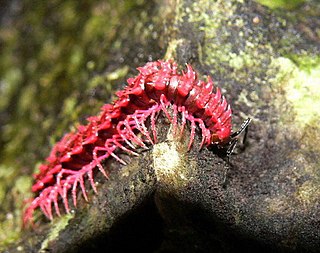
Illacme plenipes is a siphonorhinid millipede found in the central region of the U.S. state of California. It has up to 750 legs. One of three known species in the genus Illacme, it was first seen in 1926, but was not rediscovered until 2005, almost 80 years after its discovery, by Paul Marek, then a Ph.D. student at East Carolina University.

Orator Fuller Cook Jr. was an American botanist, entomologist, and agronomist, known for his work on cotton and rubber cultivation and for coining the term "speciation" to describe the process by which new species arise from existing ones. He published nearly 400 articles on topics such as genetics, evolution, sociology, geography, and anthropology.

Desmoxytes, whose species are commonly known as the dragon millipedes, is a genus of millipedes of the family Paradoxosomatidae found in Southeast Asia. The genus was described by Ralph Vary Chamberlin in 1923, and reviewed by Sergei Golovatch and Henrik Enghoff in 1994. At least 18 species are known from to Malaysia, Myanmar, and Thailand. One species, D. planata, has also been observed in Sri Lanka, the Andaman Islands, Seychelles, Java, Great Coco Island, and Fiji; however, this species has expanded its range by being transported through human activity. Several species have only recently been discovered, and some have yet to be officially described.

Polydesmida is the largest order of millipedes, with more than 5,000 species, including all the millipedes reported to produce hydrogen cyanide (HCN). This order is also the most diverse of the millipede orders in terms of morphology. Millipedes in this order are found in all regions of the world other than Antarctica.

Paradoxosomatidae, the only family in the suborder Paradoxosomatidea, is a family of flat-backed millipedes in the order Polydesmida. Containing nearly 200 genera and 975 species as of 2013, it is one of the largest families of millipedes. Paradoxosomatids occur on all continents except Antarctica, and can generally be distinguished by dorsal grooves on most body segments and a dumb-bell shaped gonopod aperture. Notable groups within the Paradoxosomatidae include the dragon millipedes of Southeast Asia, and the widely introduced greenhouse millipede Oxidus gracilis.

Julida is an order of millipedes. Members are mostly small and cylindrical, typically ranging from 10–120 millimetres (0.39–4.72 in) in length. Eyes may be present or absent, and in mature males of many species, the first pair of legs is modified into hook-like structures. Additionally, both pairs of legs on the 7th body segment of males are modified into gonopods.

Chordeumatida is a large order of millipedes containing some 1200 species with a nearly worldwide distribution. Also known as sausage millipedes, they grow and develop through a series of moults, adding segments until they reach a fixed number in the adult stage, which is usually the same for a given sex in a given species, at which point the moulting and the addition of segments and legs stop. This mode of development, known as teloanamorphosis, distinguishes this order from most other orders of millipedes, which usually continue to moult as adults, developing through either euanamorphosis or hemianamorphosis.

Harold Frederick Loomis was an American botanist and myriapodologist known for his contributions to agronomy, plant pathology, and millipede taxonomy. He worked for the U.S. Department of Agriculture for over four decades, studying diseases of crop plants, and was a colleague of Orator F. Cook. He also made major contributions to the natural history of Central America and the West Indies, naming over 500 species of millipedes in total. He co-described with Cook the leggiest animal on earth: Illacme plenipes, with over 700 legs.

Orthomorpha coarctata, the long-flange millipede, is a widely introduced species of Polydesmidan millipede of the family Paradoxosomatidae. It is presumed native to Southeast Asia but due to transport by humans occurs in tropical and sub-tropical areas throughout the world, including the Hawaiian Islands, the West Indies, Gulf Coast of North America, and the Galápagos Islands.

Casimir Albrecht Willem Jeekel (1922–2010) was a Dutch myriapodologist and entomologist known for his major contributions to the taxonomy of millipedes. His 1971 monograph Nomenclator Generum et Familiarum Diplopodorum is credited as launching the "modern era" of millipede taxonomy, and has been considered the "most important single work ever published on the Diplopoda". He served as director of the Zoological Museum Amsterdam, and authored over 150 works on the taxonomy of millipedes and other myriapods.
Hylomus rhinoceros is an aposematic species of dragon millipede in the family Paradoxosomatidae. It is only known from Champasak and Sekong Provinces in southern Laos.

Cleidogonidae is a family of millipedes in the order Chordeumatida. Adult millipedes in this family have 28, 29, or 30 segments. This family includes the genus Tianella, notable for featuring adult millipedes with 29 segments, a number not found in the adults of any other chordeumatidan species. Adults in most Tianella species have 29 segments, but adults in two have only 28 segments. In the Tianella species with 29 segments, adult females have 48 pairs of legs, as one would expect in adult female chordeumatidans with one segment fewer than the 30 usually found in this order. There are seven genera and at least 140 described species in Cleidogonidae.
Tingupidae is a family of millipedes in the order Chordeumatida. Adult millipedes in this family have 28 or 30 segments. There are 2 genera and 13 described species in Tingupidae.
Chondromorpha is a genus of millipedes belonging to the family Paradoxosomatidae.
Kirkayakidae is a family of millipedes belonging to the order Chordeumatida. This family was formerly known as Altajellidae. Adult millipedes in this family have 28 segments rather than the 30 segments usually found in chordeumatidans.
Termitodesmidae is a family of millipedes belonging to the order Glomeridesmida. These millipedes are found in India, Sri Lanka, and Vietnam. The five known species in this family are notable in that they are found only in termite mounds. Termitodesmidae is the only myriapod family known to depend on insects in such a commensal relationship.

Desmoxytes cervina, is a species of millipede in the family Paradoxosomatidae. It is known from Myanmar and Thailand.

Desmoxytes golovatchi, is a species of millipede in the family Paradoxosomatidae, that can be found in Thailand.
Stosatea italica is a species of millipede in the family Paradoxosomatidae.
Agenodesmus is a genus of millipedes in the family Fuhrmannodesmidae, which some authorities consider a junior synonym of Trichopolydesmidae. This genus is notable for being among the very few genera in the order Polydesmida to feature adults with only 18 segments rather than the 20 segments usually found in this order. The genus Agenodesmus contains only two species, A. reticulatus and A. nullus. The type species A. reticulatus is notable as the first polydesmidan millipede discovered with only 18 segments in adults, the smallest number recorded in the order Polydesmida. Before the discovery of A. reticulatus, polydesmidans were known to have only 19 or 20 segments in adults.














